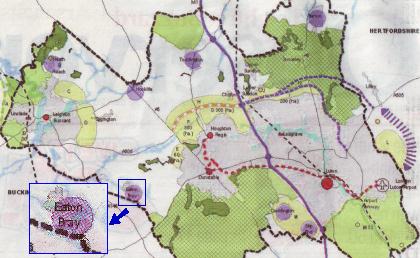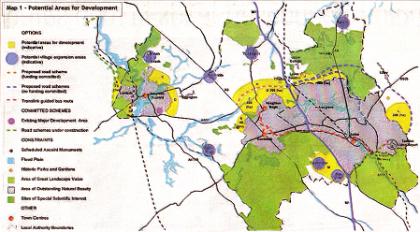Archived News - Development
Where should new estates go? It's time to speak out
The public is finally having its say on controversial plans to build thousands of homes in Leighton-Linslade - but they're being warned that there is now no stopping the development of the area.
Road-shows, manned by planners and council officers, will be coming to the town and nearby villages in July at the start of a three-month consultation exercise asking for the public's views on where massive new house building should go. There will be leaflets to every house in the district and an informative website. Everyone is being invited to comment.
But what they can't say is that "we don't want it." Councillor Tom Nicols, head of a powerful planning committee charged with finding room for 43,000 homes in Luton and South Beds, said development had to go somewhere in the areas indicated in yellow and purple on the map above, and it was now up to the public to give their opinions on where. "Saying no is not an option," he said.

The yellow patches are proposed areas where expansion will be considered. Villages circled with purple could also be in the frame for some development, but the areas finally approved for development may be smaller in size.
Click image for full sized version.
There is a discernable change in tone from the draft consultation document revealed only seven weeks ago on May 1. That suggested that Leighton-Linslade and nearby villages could be completely spared from further development if enough people spoke out strongly against it. Five out of ten option maps shown in the draft did not include any new estates for the town at all and only one option out of ten proposed building in our villages. Half the options indicated that all of the new homes could be fitted around Luton and Dunstable.
Now, however, councillors are talking in a manner that makes clear they would only permit this to happen if they could be persuaded by a very strong, factual case indeed. Realistically, it seems Leighton must expect more estate building - the main questions are how much and where.
The committee had originally been told to site new homes in areas of deprivation - parts of Luton, Dunstable and Houghton Regis - in the hope that the accompanying infrastructure would regenerate the region. Leighton-Linslade had not been included in the equation.
But Ian Slater, Luton Council's head of planning, told a press conference to launch the consultation exercise: "Because Leighton-Linslade Town Council argued strongly that it wanted growth the government suggested we looked at Leighton-Linslade."
Initially the Luton/Dunstable/ Houghton Regis and Leighton-Linslade growth area joint planning and transportation committee asked landowners simply to identify any areas capable of sustaining housing.
While most came back earmarking plots of land in the district, a group of developers, headed by Arnold White and Willis Dawson, went one further and commissioned an in-depth blueprint on expanding the town by a third. They also encouraged local landowners to join their Eastern Leighton-Linslade Partnership with claims of offers of up to £lmillion an acre.
A storm of protest erupted in September after the LBO exclusively revealed details of their planning brief. It suggested a scheme to site at least 6,000 houses (first phase) plus £50million of infrastructure that will include a new arterial duel-carriageway running from the Leighton Bypass to Heath Road, shops, schools, health centre, employment zones and leisure facilities.
Planners from both South Beds and Luton have studied developers' and land-owners representations and have now released an initial blueprint outlining options for growth. The maps for Leighton-Linslade highlight the east Leighton scheme plus two additional pockets of development, off Wing Road and Derwent Road, Linslade. Heath and Reach, Eaton Bray and Hockliffe are also flagged up for limited expansion while the edge of Eggington may be swallowed up by the vast eastern expansion zone.
Cllr Nicols said he wanted the public to come back with their ideas on where building should take place and the density of growth they preferred. He said: "If you go for low density, which people would demand, then we will need more land - people's paddocks will disappear.
"If we have high density then we subject the population to a less than suitable lifestyle. We want the public to give us a sense of balance.
"We won't agree the planning carte blanche. We don't want to see pieces just tacked onto Leighton-Linslade. We need to have key infrastructure in place and to integrate the growth into the existing area."
Mr Slater said the scale of growth was "massive".
"Development of this scale will require thousands of hectares but it is an amazing opportunity for the ' public to become involved," he said.
Building is not expected to begin until 2011.
Source: Leighton Buzzard Observer, 19 June 2007
Decision time on Leighton's future
Property developers with ambitions to build vast housing estates on the northern and eastern edges of Leighton Buzzard could soon see their hopes confirmed.
But on the other hand it is equally possible that Leighton-Linslade might be completely spared from massive further development beyond what is already in the planning system pipeline.
It all depends a lot on what the public tell councillors during a major initial consultation due to start in a month or two's time. If a large majority of people in the town and nearby villages present a strong voice against thousands more homes being added to Leighton's allocation up to 2031, it should have a big influence on the decisions that follow.

The yellow patches are the maximum potential areas where councillors think new building could be allowed: Click image for full sized version.
A new draft council document indicates that it could still be a realistic aim to place most or even all of the 37,000 new south Bedfordshire homes demanded by the government in Luton and Dunstable.
Ten possible options for building in the district during the coming 24 years have been proposed in a 44-page document called the Core Strategy - Draft Issues and Options Paper.
This includes background information, discussion about transport, jobs, the role of town centres and the need for community facilities.
The Core Strategy is the first fundamental step towards detailed zoning of land for new development by a committee made up of district, county and Luton councillors. This Joint Planning and Transportation Committee includes representation from Milton Keynes and others involved in implementing the Milton Keynes and South Midlands Sub-Regional Strategy.
The committee is working at this stage to decide in outline where the development should go, so detailed planning of estate roads, factories and health centres is well in the future. But although the core strategy only talks about ''five possible alternative approaches to how the development could be distributed'', it is highly important in showing the areas that the committee is interested in considering - and for showing the areas that are not in the frame for rolling back the green belt.
The five options illustrated on maps of south Bedfordshire are headed:
- Development limited to within the bypasses.
- Development not limited to within the bypasses.
- Maximise proximity to town centres and main employment areas.
- Widespread distributional spread.
- Development focussed on Luton.
Each of these is also depicted with minimum and maximum areas of land being allocated for development, depending on the density of housing per acre that is finally decided on.
Densely-packed blocks of flats could obviously provide homes for more people in a smaller area than larger houses with gardens and this would have a direct impact on the amount of green belt countryside that will have to be built on to achieve the government's required total. But social factors also need to be considered and final announcements could be two years away.
Areas that are in the frame to be considered include:
- The land between Derwent Road, and the new Linslade Bypass, bounded by Soulbury Road to the north.
- An arc of land wrapping round the eastern side of Leighton from Cotefield Drive and Heath Road in the north west to the A505 Leighton Bypass in the south. This area is bounded by Shenley Hill Road to the north and stops short of Eggington in the east, but is broken in two by a gap for the Clipstone Brook flood plain. It includes most of the land proposed for future development by a local consortium of land-owners and builders, as exclusively revealed by the LBO last year, if they are allowed to proceed.
- n A 30-hectare strip beside the railway line between Wing Road, on the southern edge of Linslade, and the Leighton Bypass, but not extending up Wing Hill.
- General development in the villages of Heath and Reach, Eaton Bray, Hockliffe, Barton, Toddington, Caddington and Slip End. Five of the ten options do not propose any extra development around Leighton-Linslade, confining it all to extensions of Luton, Dunstable and Houghton Regis.
Objectors who fear that Leighton couldn't cope with thousands more homes and are sceptical about sufficient infrastucture being provided will take heart from this and drive home their case when the Core Strategy questionnaire is made available to the public.
Only one option - "Widespread development, maximum land-take" - suggests allowing development in Heath and Reach, Hockliffe and Eaton Bray. Heath is certainly expected to oppose this idea forcefully, having just reported in its newly-published Parish Plan that 92% of residents voted against any changes whatever being made to the existing green belt.
Stanbridge, Tilsworth, Eggington and Billington are not being mooted for inclusion in the development areas.
You can view and download The Core Strategy Draft Issues and Options Paper on http://agendas.luton.gov.uk/cmiswebpublic/binary.ashx?Document=11439.
Source: Leighton Buzzard Observer, 1 May 2007